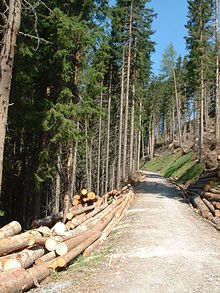Forestry
Forestry work in Austria.
 Silviculture, a related science, involves the growing and tending of trees and forests. Modern forestry generally embraces a broad range of concerns, including assisting forests to provide timber as raw material for wood products, wildlife habitat, natural water quality management, recreation, landscape and community protection, employment, aesthetically appealing landscapes, biodiversitywatershed management, erosion control, and preserving forests as 'sinks' for atmospheric carbon dioxide. A practitioner of forestry is known as a forester. Note that the word "forestry" can also refer to a forest itself. management,
Silviculture, a related science, involves the growing and tending of trees and forests. Modern forestry generally embraces a broad range of concerns, including assisting forests to provide timber as raw material for wood products, wildlife habitat, natural water quality management, recreation, landscape and community protection, employment, aesthetically appealing landscapes, biodiversitywatershed management, erosion control, and preserving forests as 'sinks' for atmospheric carbon dioxide. A practitioner of forestry is known as a forester. Note that the word "forestry" can also refer to a forest itself. management, Forest ecosystems have come to be seen as the most important component of the biosphere, and forestry has emerged as a vital field of science, applied art, and technology.
History
 The use and management of many forest resources has a long history in China, dating from the Han Dynasty and taking place under the landowning gentry. It was also later written of by the Ming DynastyXu Guangqi (1562–1633). In the Western world, formal forestry practices developed during the Middle Ages, when land was largely under the control of kings. Control of the land included hunting rights, and though peasants in many places were permitted to gather firewood and building timber and to graze animals, hunting rights were retained by the members of the nobility. Systematic management of forests for a sustainable yield of timber is said to have begun in the 16th century in both the German states[citation needed] and Japan. Typically, a forest was divided into specific sections and mapped; the harvest of timber was planned with an eye to regeneration. Chinese scholar
The use and management of many forest resources has a long history in China, dating from the Han Dynasty and taking place under the landowning gentry. It was also later written of by the Ming DynastyXu Guangqi (1562–1633). In the Western world, formal forestry practices developed during the Middle Ages, when land was largely under the control of kings. Control of the land included hunting rights, and though peasants in many places were permitted to gather firewood and building timber and to graze animals, hunting rights were retained by the members of the nobility. Systematic management of forests for a sustainable yield of timber is said to have begun in the 16th century in both the German states[citation needed] and Japan. Typically, a forest was divided into specific sections and mapped; the harvest of timber was planned with an eye to regeneration. Chinese scholar 
The enactment and evolution of forestry laws and binding regulations occurred in most Western nations in the 20th century in response to growing conservation concerns and the increasing technological capacity of logging companies.
Tropical forestry is a separate branch of forestry which deals mainly with equatorial forests that yield woods such as teak and mahogany. Sir Dietrich Brandis is considered the father of tropical forestry.



0 Response to "Forestry"
Post a Comment